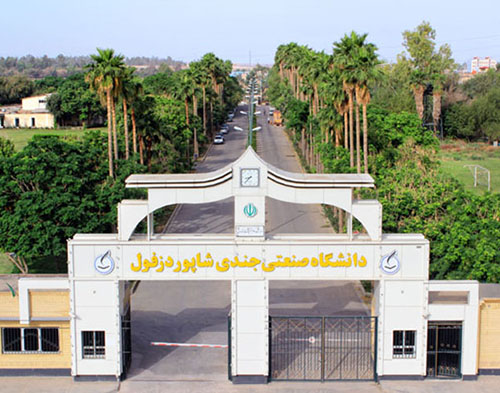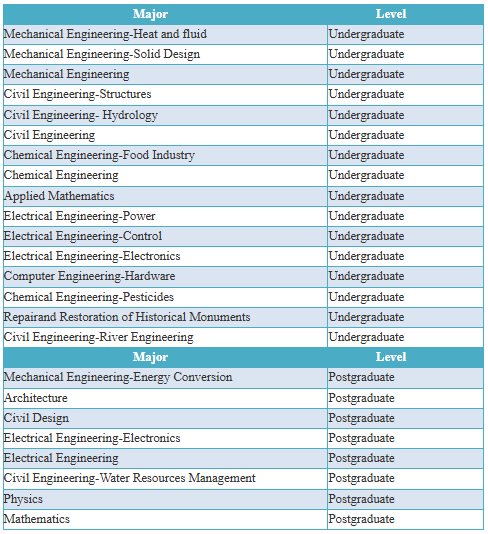ANCIENT JUNDI SHAPUR UNIVERSITY
Jundi Shapur was one of the world's birthplaces of knowledge and wisdom which is a source of national pride and enthusiasm. Our ancestors in ancient Iran cherished scholarship and wisdom and constantly endeavored to educate and illuminate the path leading to this divine gift. On November 3rd 2017, it was registered in UNESCO's List as the first institute closest in meaning to a "University" in its modern-day concept. Thus it is the most brilliant and pride-commanding event to us Iranians which we treasure for almost 18 centuries.
Jundi Shapur was built in the science-promoting city of Dezful which in ancient times was known to be a center for art and knowledge. The two most distinct features of this university which are beyond any doubt and exaggeration are production and promotion of sciences. These two elements of education are now amongst UNESCO's major goals and strategies. Today the concept of producing and sharing science constitutes bases for any movement that result in sustainable development in every way.

Nonetheless, a more fundamental concept as a precondition to achieve such sophisticated status must be underlined and that is the willingness of the people of those areas to build and establish venues for educational purposes. Building traditional Maktabs and Universities throughout Iran's long lasting culture and civilization (as testified to by scholars and philosophers of both east and west) is rare if not unique. Thus the fact that 18 centuries ago, a nation had reached such a sophisticated understanding to build such a college on such a vast scales and magnitude is worth mentioning again. In fact, modern universities and colleges we see in Iran and around the world are actually replicates and copies of the divisions and branches of the ancient Jundi Shapur College. With this wise decision of the Iranians in mind we can further discuss the two most distinguished features of this university which are producing and promoting knowledge. According to George Sarton in The History of Science, Jundi Shapur University was indeed The Place for Science.
The second distinct feature of that college was that scholars from the most remote parts of the world would come together to study and promote such disciplines as Medicine, Astronomy, Mathematics and Philosophy away from any ethnic dogmatism and strong scientific bias which characterized the pinnacle of the Iranians inclusive humanitarian view on education about 2000 years ago.
The third feature of Jundi Shapur University was training and educating students and preparing them to return to their country of origin to put their knowledge into practice, therefore it could be said that the world's very first research study opportunities were introduced by this college.
Another positive aspect of establishing this university was foundation of the largest library in the ancient world which had the capacity for 400,000 copies of books on an array of disciplines such as Medicine, Veterinary, Botany, Pharmacology, Philosophy, Mathematics, and Astronomy in Pahlavi, Greek and Sanskrit which had played a very crucial role in promoting science and broadening its boarders within the framework of the translation movement in the ancient world.
After paving the road by our ancestors, now the responsibility of promoting science lies even heavier on our shoulders. Where our ancestors had reached such levels of dominance over the vast realms of knowledge and wisdom, our duty as the inheritors of such great men becomes much more critical. If our ancestors had the courage, ability and wisdom to broaden the boarders of knowledge in the world, we too should constantly irrigate the bulking tree of our age- old Islamic Iran to make it blossom with development, prosperity and self-sufficiency, furthermore we must uphold the flag of science and culture through achieving new levels of knowledge. Because of the concurrent situations and conditions of modern societies, universities play a special educational and research roles and deal with new problems such as fast-moving changes, reconstructing situations, the use of technology, training and organizing human resources which are necessary to achieve development in addition to factors such as training skilled and professional human resources, organizing and good management of resources and facilities, promoting knowledge and raising awareness necessary for change and development, access to technology and the use of it in different sections are also of utmost significance.
Now, Jundi Shapur Industrial University of Dezful as the inheritor of the world's oldest and largest learning center of the ancient world and the symbol of Iran's higher education since antiquity, feels responsible for safeguarding and preserving Iran's invaluable scientific place, prestige and hopes to restore the historical and cultural sovereignty of the old Jundi Shapur University.
Modern Jundi Shapur Industrial University of Dezful
Given the current population of Dezful (circa. 500,000), as the second most populated city of Khuzestan province, the blueprint for building the Industrial College of Dezful was laid years before the outbreak of the Islamic Revolution of 1978. In the spring of 1972 and in the wake of the then Jundi Shapur University of Ahvaz comprehensive plan to establish a college of agriculture arrangements were made to purchase a piece of land in Saffi Abad properties of Dezful, to represent the cornerstone of the Northern College Branch of Jundi Shapur University of Ahvaz . In 1976, the organizational chart of the college was approved and four faculties, i.e. the faculties of Engineering, Sciences, Agriculture and Medicine were on the agenda to develop the Northern Branch of the University. In 1977, Dr. Ganjavian Teaching Hospital, as a faculty of Medicine, was completed. The official opening of the College was however postponed until early 1980s due to its coincidence with the outbreak of the Islamic Revolution.

The College had eleven faculty members in 1979 but unfortunately the invasion of Iraqi military campaign against Iran once more hindered the opening of the College in a dire situation that lasted till the end of the war IN 1988. During the war, all the facilities of the Northern Branch served that Sacred Defense, the Central Building of the College served as a military headquarter and a center to evacuate casualties.
After putting these setbacks behind, the educational activities of the Northern Branch started in 1988 when the College began admitting students in two majors; Mechanical engineering and Civil engineering. Between 1998 and 2004 the College mainly focused on equipping its labs, workshops and libraries and made some notable accomplishments. Furthermore recruiting new faculty members and accommodating the professors to pursue their higher education career was among the college priorities. In the winter of 2005, the Ministry of Sciences agreed to promote the Northern Branch to a Higher Education Institute, and in the spring of the same year gained its full independence, financially, educationally, in administration and constructional projects. In 2006, promoting the Institute to a University was proposed during a government cabinet meeting.
To operationalize the issue, the Chancellor's number one priority became to provide the required facilities and meeting the conditions (such as allotment of a land of 65 hectares, announcement of a new organizational chart with the structure of a University in 2007, obtaining the legal permit to establish 3 more colleges) in order to be promoted to a university in addition to waging extensive efforts by the Chancellor regarding this particular policy. In 2010, the National Council of Higher Education Promotion passed a resolution to approve the change from a Higher Education Institute to a University and in the summer of the same year, Ministry of Sciences announced the promotion of Jundi Shapur Higher Education Institute to Jundi Shapur Industrial University of Dezful.
Today, The JSIUD include 8 faculties and a Research Center(Type A) , over a 100 hectare land , another 100 hectares being allocated to field research purposes.
The University's mission assigned by the Culture and Civilization Committee of the Cultural Revolution Supreme Council is defined as cooperating with The National Commission of UNESCO and Iranian Cultural Heritage Organization and the Organization of Budget and Planning to hold a Permanent Secretariat of the International Congress of Jundi Shapur with the objective to provide all the facilities of the aforementioned organizations and receive international and public donations in order to redefine and/or reintroduce the invaluable global heritage of Jundi Shapur and to safeguard and preserve this Iranian symbol of knowledge.
Jundi Shapur Industrial University of Dezful admits students in 25 majors at both undergraduate and postgraduate levels:


